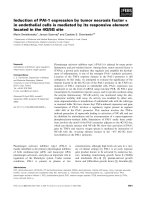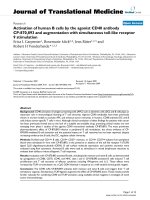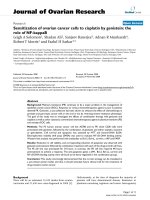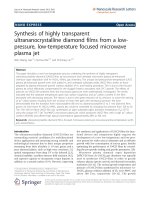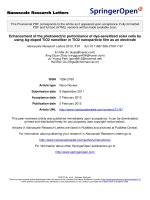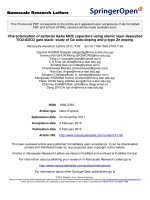Báo cáo toán học: " Enhancement of the photoelectric performance of dye-sensitized solar cells by using Ag-doped TiO2 nanofiber in TiO2 nanoparticle film as an electrode" pot
Bạn đang xem bản rút gọn của tài liệu. Xem và tải ngay bản đầy đủ của tài liệu tại đây (2.21 MB, 16 trang )
This Provisional PDF corresponds to the article as it appeared upon acceptance. Fully formatted
PDF and full text (HTML) versions will be made available soon.
Enhancement of the photoelectric performance of dye-sensitized solar cells by
using Ag-doped TiO2 nanofiber in TiO2 nanoparticle film as an electrode
Nanoscale Research Letters 2012, 7:97 doi:10.1186/1556-276X-7-97
En Mei Jin ()
Xing Guan Zhao ()
Ju-Young Park ()
Hal-Bon Gu ()
ISSN 1556-276X
Article type Nano Review
Submission date 9 September 2011
Acceptance date 2 February 2012
Publication date 2 February 2012
Article URL />This peer-reviewed article was published immediately upon acceptance. It can be downloaded,
printed and distributed freely for any purposes (see copyright notice below).
Articles in Nanoscale Research Letters are listed in PubMed and archived at PubMed Central.
For information about publishing your research in Nanoscale Research Letters go to
/>For information about other SpringerOpen publications go to
Nanoscale Research Letters
© 2012 Jin et al. ; licensee Springer.
This is an open access article distributed under the terms of the Creative Commons Attribution License ( />which permits unrestricted use, distribution, and reproduction in any medium, provided the original work is properly cited.
Enhancement of the photoelectric performance of dye-sensitized solar cells
using Ag-doped TiO
2
nanofibers in a TiO
2
film as electrode
En Mei Jin*
1
, Xing Guan Zhao
1
, Ju-Young Park
2
, and Hal-Bon Gu*
1
1
Department of Electrical Engineering, Chonnam National University, Gwangju, 500-757, South
Korea
2
Southwestern Research Institute of Green Energy Technology, Mokpo-si, Jeollanam-do, 530-
400, South Korea
*Corresponding author:
Email addresses:
EMJ:
XGZ:
J-YP:
H-BG:
Abstract
For high solar conversion efficiency of dye-sensitized solar cells [DSSCs], TiO
2
nanofiber [TN]
and Ag-doped TiO
2
nanofiber [ATN] have been extended to be included in TiO
2
films to
increase the amount of dye loading for a higher short-circuit current. The ATN was used on
affected DSSCs to increase the open circuit voltage. This process had enhanced the exit in dye
molecules which were rapidly split into electrons, and the DSSCs with ATN stop the
recombination of the electronic process. The conversion efficiency of TiO
2
photoelectrode-based
DSSCs was 4.74%; it was increased to 6.13% after adding 5 wt.% ATN into TiO
2
films. The
electron lifetime of DSSCs with ATN increased from 0.29 to 0.34 s and that electron
recombination was reduced.
Keywords: dye-sensitized solar cell; TiO
2
; nanofiber; doping; solar conversion efficiency.
Introduction
Since the Grätzel group discovered dye-sensitized solar cells [DSSCs], many people became
interested. The low-cost, high-solar conversion efficiency of DSSCs is considered as a possible
alternative to the present silicon solar cells [1-3]. DSSCs employ a sensitizer (dye) adsorbed on a
surface of a wide energy bandgap semiconductor and electrolyte dissolving redox couples such
as I
−
/I
3
−
and platinum [Pt] counter electrode [4]. In DSSCs, the photoexcited electrons of the dye
adsorbing on the TiO
2
surface are transferred to the conduction band of TiO
2
, which are then
taken to an outer circuit using a fluorine-doped tin oxide [FTO] substrate and a counter electrode,
respectively, and then the electrons are passed to an electrolyte [5, 6]. So, in order to get a high
solar conversion efficiency in DSSCs, a high surface area for the porous TiO
2
films for efficient
absorption of the sensitizer and good networking between the particle to particle or particle to
FTO substrate are very important [7-10]. So far, the TiO
2
-based DSSCs fabricated using
multilayer approaches have shown the solar conversion efficiency of 11.3%, which is lower than
the theoretical maximum (33%) [11, 12]. So many research, in order to increase the solar
conversion efficiency in DSSCs, have been studied about photoelectrodes such as synthesis of
the wide bandgap of TiO
2
, the small particle size of 10 to approximately 20 nm, the wide surface
area of TiO
2
, and the porosity. As stated above, these can increase the adsorption of dye, and by
extension, the solar conversion efficiency could be increased [13, 14].
In this study, DSSCs fabricated with a TiO
2
nanofiber [TN] and an Ag-doped TiO
2
nanofiber
[ATN] were used to increase the TiO
2
film's surface area for dye adsorption. The study has
discussed the electrochemical properties of the TN-added cells or the ATN-added cells by
photocurrent-voltage curves.
Experiment
Preparation of TN and ATN
TN was fabricated using the electrospinning technique [15]. The electrospinning technique has
been recognized as a versatile and effective method for the production of fibers with small
diameters and with high surface-to-volume ratio [16-18]. It is demonstrated that titanium
isopropoxide [TiP] can be added directly to an alcohol solution containing polyvinylpyrrolidone
[PVP] (with a molecular weight [MW] of 1,300,000). To suppress the hydrolysis reaction of the
sol-gel precursor, acetic acid as well as PVP solution in ethanol must be added. TiP of 6 mL was
mixed with 12 mL acetic acid and 12 mL ethanol. After 60 min, this solution was added to 30 g
ethanol that contained 10 wt.% PVP and 1.986 mL of 0.5-N AgNO
3
(5% TiP mol), followed by
magnetic stirring for 24 h. The spinning solution underwent electrospinning with an applied
voltage of 20 kV, a flow rate of 50 µL/min, and a tip to collector distance of 15 cm. The prepared
electrospun fiber was calcinated at 500°C.
Preparation of the TiO
2
photoelectrode and the Pt electrode
TiO
2
paste was prepared by mixing nitric acid-treated and nanosized TiO
2
(P-25, Degussa,
Evonik Industries, Essen, Germany) powder with acetyl acetone, nitric acid, ethanol, distilled
water, Triton X-100, and polyethylene glycol (Junsei Chemical Co., Ltd., Chuo-ku, Tokyo,
Japan; average MW 20,000) binders for 10 h at 300 rpm by using the Planetary Mono Mill
(pulverisette 6, Fritsch GmbH, Idar-Oberstein, Germany). In this process, the TiO
2
powder was
treated with nitric acid. The 12-g TiO
2
(P-25) powder was mixed with distilled water and nitric
acid (v/v, 120:1) at 80°C for 8 h using a hot plate. After mixing, the TiO
2
nitric acid solution was
dried at 100°C for 24 h. The prepared TiO
2
paste was cast on pre-cleaned FTO (Pilkington FTO
glass, Nippon Sheet Glass Co., Ltd., Minato-ku, Tokyo, Japan; 8 Ω/cm
2
) using the squeeze
printing method. The coated TiO
2
films were sintered at 450°C for 30 min. The active area of the
TiO
2
film was 0.25 cm
2
. The TiO
2
film was immersed into a 5 × 10
−4
-mol/L ethanol solution of
Ru(dcbpy)
2
(NCS)
2
(535-bis, Solaronix Co., Aubonne, Switzerland) overnight, then rinsed with
anhydrous ethanol, and finally dried. The counter electrode was prepared using the squeeze
printing technique and subsequently sintered at 450°C for 30 min. The counter electrode material
was a Pt catalyst (Solaronix Co.).
Assembly of the testing cells
The Pt electrode was placed over the dye-adsorbed TiO
2
electrode, and the edges of the cell were
sealed. The sealing was accomplished by hot-pressing two electrodes together at 120°C. The
redox electrolyte was injected into the cell through two small holes drilled in the counter
electrode. The redox electrolyte was composed of 0.3 mol/L 1,2-dimethyl-3-propylimidazolium
iodide (Sigma-Aldrich Corporation, St. Louis, MO, USA), 0.5 mol/L 4-tert-butylpyridine
(Sigma-Aldrich Corporation), and 3-metoxypropionitrile as solvent. The holes were then covered
and sealed with a small square of sealing material and microscope objective glass.
Measurements
The crystalline phase of the prepared TN and ATN was obtained by high resolution X-ray
diffractometry [XRD] (D/MAX Ultima III, Rigaku Corporation, Tokyo, Japan) using CuKα
radiation, and field-emission scanning electron microscopy [FE-SEM] (S-4700, Hitachi High-
Tech, Minato-ku, Tokyo, Japan) and energy dispersive X-ray spectrometry [EDX] (EMAX
Energy EX-200, HORIBA Ltd., Minami-Ku, Kyoto, Japan) were used to examine the
morphology and chemical element analysis of the TiO
2
film.
In order to investigate the physical and optical characteristics of the natural dyes, the UV-visible
spectrum measurement was performed. The photovoltaic properties were investigated by
measuring the photocurrent-voltage characteristics under illumination with an air mass [AM] of
1.5 (100 mW/cm
2
) simulated sunlight. The charge transport characteristics were investigated by
intensity-modulated photovoltage spectroscopy [IMVS]. The IMVS was measured using red
light-emitting diodes [LED] (635 nm). The light intensities were modulated by 10% in a
frequency range typically from 0.01 to 100 Hz.
Results and discussion
Figure 1 shows the XRD patterns of pure TN and ATN at a calcination temperature of 500°C. In
a study by Park et al. [19], silver had a down phase transition temperature to that of TN. The
anatase ratio of the corresponding plane (101) extracted from the XRD pattern was calculated
using the Spurr equation against the corresponding plane (101) [20]. Pure TN was only observed
on the anatase phase; ATN was observed on both the anatase (46%) and rutile (54%) phases.
The surface morphologies of the pure TiO
2
photoelectrode and TiO
2
photoelectrode with TN or
ATN TiO
2
films were obtained by FE-SEM and are depicted in Figure 2. The pure TiO
2
film
observations show very good film surface uniformity with about 25 nm TiO
2
nanoparticles and
thin film porosity. TN and ATN nanofibers can be observed at the surface of the film, so the
nanofiber-added TiO
2
film has an advantage to having higher adsorption of dye molecules and
also supports the penetration of the I
−
/I
3
−
redox couple into the TiO
2
film. Moreover, the surface
area of the TiO
2
films was larger, so the dye molecule adsorption space was also larger.
Consequently, the increased surface absorption enhanced the solar energy conversion efficiency.
Figure 3 and Table 1 show the EDX results of pure TiO
2
films with 5 wt.% TN or ATN. It was
found that the distribution of TN and ATN on pure TiO
2
films and on the Ru element has
increased. Figure 3 shows that the Ru peak energy around 2.2 keV was higher in the 5 wt.% ATN
than those of other samples and the weight of Ru is 0.42 at.%. So, the ATN on the TiO
2
film gave
a higher adsorption of dye (Ru) molecules and also supported electron transfer in the TiO
2
film.
Consequently, increased adsorption of dye and electron transfer enhanced the solar energy
conversion efficiency.
Figure 4 shows the photocurrent-voltage characteristics of a sandwich solar cell based on a TiO
2
film with different amounts of TN. The solar cell irradiated with a 1,000-W xenon lamp with a
light intensity of 100 m/cm
2
as a light source. The short-circuit current density [J
sc
] and the open
circuit voltage [V
oc
] values of the solar cell on pure TiO
2
film are 11.14 mA/cm
2
and 0.67 V,
respectively. The fill factor [FF] value is 64%, and the solar energy conversion efficiency [
η
]
value is 4.74%. The
η
of the TiO
2
film with 5 wt.% TN is higher than those with other contents
(such as 3 wt.% and 7 wt.%), and V
oc
, J
sc
, FF, and
η
values are 0.64%, 13.77 mA/cm
2
, 59%, and
5.22%, respectively.
Figure 5 shows the photocurrent-voltage characteristics of DSSCs sensitized with different
amounts of ATN. The
η
of the TiO
2
film with 5 wt.% ATN was the best at 6.13%; the ATN on a
nanocrystalline TiO
2
film enhanced the charge recombination, and there was a 129%
improvement in the photovoltaic device solar conversion efficiency.
Figure 6 shows the photocurrent density and
η
of pure TiO
2
films, TiO
2
films with 5 wt.% TN,
and TiO
2
films with 5 wt.% ATN. The photocurrent density and
η
of DSSCs with 5 wt.% ATN
were the best among the samples.
The electron lifetimes within DSSCs are determined primarily by the recombination of electrons
with iodine, electrolyte, and oxidized sensitizers. To understand the recombination lifetime, T
n
was determined using the relation
n
min
1
=
2
T
f
π
, where f
min
is the frequency giving the lowest
imaginary component in IMVS. So, we are using IMVS to analyze the lifetime of DSSCs with
ATN; the charge transport characteristics were investigated by IMVS. The IMVS are shown in
Figure 7. IMVS was measured using LED (635 nm). The light intensities were modulated by
10% in a frequency range typically from 0.01 to 100 Hz. The electron lifetime was increased by
adding ATN, and this sample had the highest photovoltage compared with the others. The results
are consistent with the photocurrent-voltage curves. The electron lifetime of DSSCs with ATN
increased from 0.29 to 0.34 s. This result clearly indicates that electron recombination with the
oxidized species is reduced by adding ATN in the TiO
2
film. This can be understood by either
looking at the improved connection of TiO
2
nanoparticles or the Ag effect of the electrons during
transition. The increased electron lifetime and the reduction of the electron transit time can
explain the increment of J
sc
by the addition of ATN.
Conclusions
In conclusion, TN and ATN were added into the TiO
2
film of DSSCs. An enhanced
η
of 129%
was achieved from the 5 wt.% ATN concentration. The added ATN had also contributed toward
the enhancement of dye adsorption as seen from EDX results, and surface area was increased by
the fibers. It gives many absorption sites for the dye, and the ATN that was added to the TiO
2
film enhanced the charge recombination. The study has shown that the performance of DSSCs
can be strongly improved using fibers. An
η
of approximately 6.13% has been achieved for
DSSCs with ATN at the irradiation condition of AM 1.5 (100 mW/cm
2
) simulated sunlight, and
J
sc
, V
oc
, and FF are 14.93 mA/cm
2
, 0.68 V, and 60%, respectively. It is understood that the
lifetime of DSSCs was increased by the addition of the ATN and that electron recombination
was reduced.
Competing interests
The authors declare that they have no competing interests.
Authors' contributions
EMJ participated in the fabrication of DSSCs and in the analysis of photocurrent-voltage
characteristics. XGZ was involved in the FE-SEM, EDX, and IMVS analyses of TiO2 films and
TN- and ATN-doped TiO2 films. J-YP participated in the preparation of TN and ATN, and in the
analyses of XRD and FE-SEM results. H-BG is the thesis director. All authors read and approved
the final manuscript.
Acknowledgments
This research was financially supported by the Ministry of Education, Science and Technology
(MEST) and Korea Industrial Technology Foundation (KOTEF) through the Human Resource
Training Project for Regional Innovation.
References
1. Jeong J-A, Kim H-K: Thickness effect of RF sputtered TiO
2
passivating layer on the
performance of dye-sensitized solar cells. Solar Energy Mater Solar Cells 2011, 95:344-
348.
2. Umar A: Growth of comb-like ZnO nanostructures for dye-sensitized solar cells
applications. Nanoscale Res Lett 2009, 4:1004-1008.
3. Lee SJ, Cho IH, Kim H, Hong SJ, Lee HY: Microstructure characterization of TiO
2
photoelectrodes for dye sensitized solar cell using statistical design of experiments.
Trans Electr Electron Mater 2009, 10:177-181.
4. Jin EM, Park K-H, Jin B, Yun J-J, Gu H-B: Photosensitization of nanoporous TiO
2
films
with natural dye. Phys Scr T 2010, 139:014006.
5. Jung Y-S, Priya ARS, Lim MK, Lee SY, Kim K-J: Influence of amylopectin in
dimethylsulfoxide on the improved performance of dye-sensitized solar cells. J
Photochem Photobiol A: Chem 2010, 209:174-180.
6. Lee K-M, Hu C-W, Chen H-W, Ho K-C: Incorporating carbon nanotube in a low-
temperature fabrication process for dye-sensitized TiO
2
solar cells. Solar Energy Mater
Solar Cells 2008, 92:1628-1633.
7. Park K-H, Jin EM, Gu HB, Shim SE, Hong CK: Effects of HNO
3
treatment of TiO
2
nanoparticles on the photovoltaic properties of dye-sensitized solar cells. Mater Lett
2009, 63:2208-2211.
8. Jin EM, Park K-H, Yun J-J, Hong CK, Hwang M-J, Park B-K, Kimm K-W, Gu H-B:
Photovoltaic properties of TiO
2
photoelectrtode prepared by using liquid PEG-EEM
binder. Surface Rev Lett 2010, 17:15-20.
9. Horea S, Vetter C, Kerna R, Smit H, Hinsch A: Influence of scattering layers on efficiency
of dye-sensitized solar cells. Solar Energy Mater Solar Cells 2006, 90:1176-1188.
10. Ko KH, Lee YC, Jung YJ: Enhanced efficiency of dye-sensitized TiO
2
solar cells (DSSC)
by doping of metal ions. J Colloid Interface Sci 2005, 283:482-487.
11. Fuke N, Fukui A, Islam A, Komiya R, Yamanaka R, Harima H, Han L: Influence of
TiO
2
/electrode interface on electron transport properties in back contact dye-sensitized
solar cells. Solar Energy Mater Solar Cells 2009, 93:720-724.
12. Xu C, Shin P, Cao L, Wu J, Gao D: Ordered TiO
2
nanotube arrays on transparent
conductive oxide for dye-sensitized solar cells. Chem Mater 2010, 22:143-148.
13. Tang Y-B, Lee C-S, Xu J, Liu Z-T, Chen Z-H, He Z, Cao Y-L, Yuan G, Song H, Chen L,
Luo L, Cheng H-M, Zhang W-J, Bello I, Lee S-T: Incorporation of graphenes in
nanostructured TiO
2
films via molecular grafting for dye-sensitized solar cell
application. Am Chem Soc 2010, 4:3482-3488.
14. Nair AS, Jose R, Yang S, Ramasrishna S: A simple recipe for an efficient TiO2 nanofiber-
based dye-sensitized solar cell. J Colloid Interface Sci 2011, 353:39-45.
15. Park JY, Lee IH, Bea GN: Optimization of the electrospinning conditions for preparation
of nano fibers from polyvinylacetate (PVAc) in ethanol solvent. J Ind Eng Chem 2008,
14:707-713.
16. Park JY, Lee I-H: Characterization and morphology of prepared titanium dioxide nanofibers
by electrospinning. J Nanosci Nanotechnol 2010, 10:3402-3405.
17. Li D, Xia Y: Fabrication of titania nanofibers by electrospinning. Nano Lett 2003, 3:555-
560.
18. Ding B, Kim H, Kim C, Khil M, Park S: Preparation and characterization of nanoscaled
poly(vinyl alcohol) fibers via electrospinning. Nanotechnol 2003, 14:532-537.
19. Park JY, Yun J-J, Hwang C-H, Lee I-H: Influence of silver doping on the phase
transformation and crystallite growth of electrospun TiO
2
nanofibers. Mater Lett 2010,
64:2692-2695.
20. Spurr RA, Myers H: Quantitative analysis of anatase-rutile mixtures with an X-ray
diffractometer. Anal Chem 1957, 29:760-762.
Figure 1. XRD patterns of ATN and TN.
Figure 2. FE-SEM images. Pure TiO
2
film and TiO
2
films with TN and ATN.
Figure 3. EDX of TiO
2
films. Pure TiO
2
film (straight line) and TiO
2
films with 5 wt.% TN
(dotted line) or 5 wt.% ATN (broken line).
Figure 4. Photocurrent-voltage characteristics of TiO
2
film with different amounts of TN.
Figure 5. Photocurrent-voltage characteristics of TiO
2
film with different amounts of ATN.
Figure 6. Photocurrent density and
η
η η
η
of pure TiO
2
films and with 5 wt.% TN and ATN.
Figure 7. DSSCs' intensity-modulated photovoltage spectroscopy results. Pure TiO
2
film
(black filled circle) and TiO
2
films with 5 wt.% TN (blue empty square) or ATN (red
inverted filled triangle).
Table 1. EDX data of pure TiO
2
films and TiO
2
films with 5 wt.% TN or ATN
Pure TiO2
(total = 100)
5 wt.% TN
(total = 100)
5 wt.% ATN
(total = 100)
Compound
wt.% at.% wt.% at.% wt.% at.%
OK 46.77 72.62 47.03 72.89 43.24 70.00
TiK 52.39 27.17 51.81 26.82 54.39 29.41
RuL 0.84 0.21 1.17 0.29 1.62 0.42
AgL - - - - 0.75 0.18
